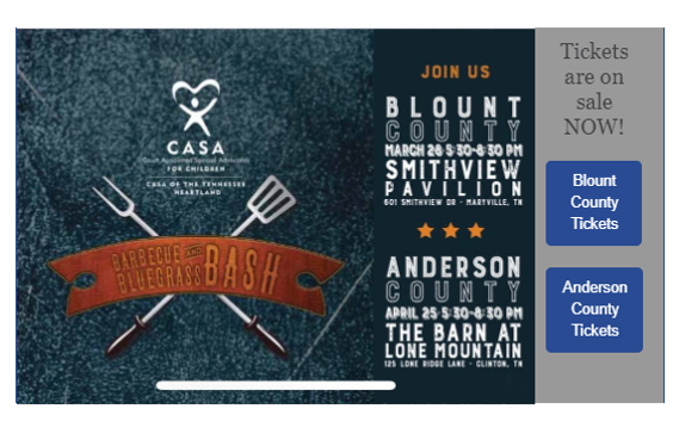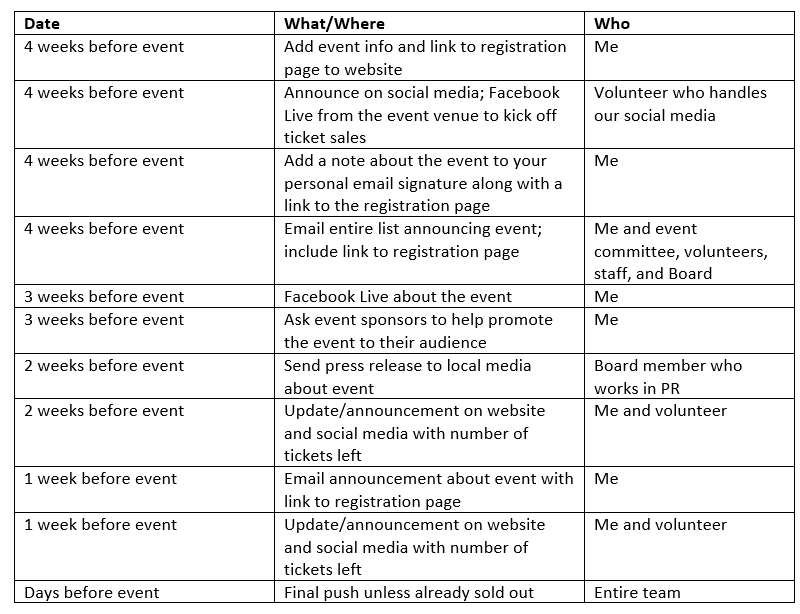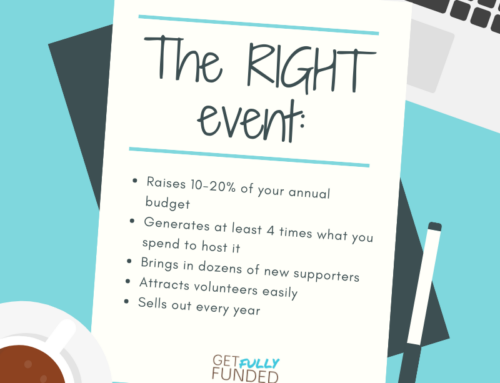
For small nonprofits, the right fundraising event can be a great way to raise money.
It can also be a LOT of work.
And a little scary.
A good fundraising event requires investing a lot of time, effort, and money upfront without knowing what the payoff will be.
In some ways, you’re working on faith – faith in yourself that you’ve planned a successful event and faith in your supporters that they’ll attend.
If you’re like most, you plan with positive expectation but also some worries…
What if they think the event sounds boring? What if everyone in town is busy that night? What if no one buys a ticket??
Or worse, what if you only sell a few?
I get it. Planning a big event can feel like a roll of the dice.
But what if I told you that you can sell out your fundraising event?
No matter where you’re located. No matter the size or age of your nonprofit. No matter YOUR experience with events.
And it doesn’t have to be hard.
Look, I’ve personally planned and hosted sold-out events and I’ve helped lots of other people do it, too.
So, let me show you what it takes to get the kind of support your fundraising event needs so there are no empty seats when the doors open.
What it takes to sell out a fundraising event
A sold-out fundraising event is not only financially rewarding but can be a lot of fun and just plain feels GREAT!
When all tickets are sold, the room is full, there’s a buzzing energy, and you can feel an underlying current of success simply from the number of people in attendance.
There’s something about a full room that subconsciously communicates success. And attendees are more likely to be in a positive, giving mood when they feel that the event is a success.
The really good news is that ANY size nonprofit in ANY location can sell out a fundraising event. You don’t have to be in a large city or have years of experience on your side. Even nonprofits in rural areas or those just getting started can sell out an event.
Here are four things that make a sell-out easier.
 1. A well-connected committee. If you really want your fundraising event to sell out, get the right people on the planning committee and gather them as early as possible.
1. A well-connected committee. If you really want your fundraising event to sell out, get the right people on the planning committee and gather them as early as possible.
You don’t want just anyone on this committee. The chemistry among committee members is important. Being part of this committee should be fun and rewarding, not a drag, so start thinking about how you can create the fun — starting with choosing the right people to serve on the committee.
Recruit committee members with lots of connections in town, especially with business owners, corporate executives, local media, known philanthropists, and community volunteers. Committee members who have great connections and who are willing to leverage those connections can help you get sponsorships and fill tables.
Remember that your Board is not your planning committee! You already know that asking Board members to sell sponsorships, sell tickets, or fill a table doesn’t always work. It’s certainly appropriate to ask for their help with the event and if any Board members would be a good fit on the planning committee, give them a seat. They’ll be able to help you report back to the full Board about the committee’s progress.
2. A solid event plan and timeline. The key to selling out your event is starting early with a well-thought-out plan. Start planning your fundraising event at least six months in advance (9-12 months in advance is better) so you have plenty of time to sell sponsorships and develop your marketing plan for filling the room. If you wait until the last minute, you may find that your intended audience has other plans.
3. A fun name and vibe. People want to attend events that look like a lot of fun, so make yours look like the MOST fun! Think about it, would you rather go to the Fifth Annual Library Patrons Banquet or the Imagination Masquerade? Fundraising events with fun names almost advertise themselves.
Here’s an example of a fun event called Bluegrass and Barbeque Bash for CASA of the Tennessee Heartland:

4. Make buying tickets easy. No matter how much advertising you do and how exciting you make your event seem, you will lose ticket sales if you make purchasing them difficult.
Make sure that you have a simple and easy ticketing system that takes only a few clicks to go from start to finish. Make sure that online buyers can click straight through from a social media post or your website to the landing page where they can buy the ticket.
Be sure to test the system before you start promoting ticket sales so you KNOW it’s working! You don’t want to get messages from frustrated event patrons that they can’t get the link on the website to work or their credit card won’t go through.
How to sell out your fundraising event
Create a ticket sale plan for your fundraising event
Once you decide HOW you’ll sell tickets, create a plan to map out which strategies you’ll use and how the numbers add up.
Estimate the number of corporate sponsors you plan to recruit and how many tables that will require. Don’t guess here – you don’t want empty tables! Base your estimate on the sponsorships you sold last year and the hot prospects you have for this year. If you start 6-9 months ahead of time selling corporate sponsorships, you should have them mostly wrapped up before you start selling individual tickets anyway, so you should know the number of tables you need for sponsors.
Then start thinking about how many table purchases or table captains you might have and set aside enough tables for those.
Finally, consider how many individual tickets you’ll need to sell.
When added together, the total should match the number of seats available for your fundraising event.
One event I volunteered with needed half of the available tables for sponsors and another huge chunk for table purchases. There were very few individual tickets sold (maybe 10%) which made for an easy sell-out! The ticket sale plan looked like this:
| Gold sponsors ($5,000) | 2 sponsors x 1 table of 10 each = 20 seats |
| Silver sponsors ($2,500) | 6 sponsors x 1 table of 10 each = 60 seats |
| Bronze sponsors ($1,000) | 6 sponsors x 1 table of 10 each = 60 seats |
| Table purchases ($750) | 4 tables x 10 each = 40 seats |
| Individual ticket sales ($75) | 20 tickets |
| 200 seats filled – SOLD OUT! |
The Bottom Line
 Fundraising events can be a great way to raise money for your organization, find new donors, raise awareness, and more.
Fundraising events can be a great way to raise money for your organization, find new donors, raise awareness, and more.
Take the time to plan out the best way to sell tickets and tables so you have a “sold-out” crowd of ideal people who have a great time.
Additional resources
15 Ideas to Help You Sell Out Your Fundraising Event https://www.funraise.org/blog/15-ideas-to-help-you-sell-out-your-next-fundraising-event
The Top 5 Event Registration Software Platforms for Nonprofits https://www.paperlesstrans.com/what-is-the-best-event-registration-software-for-non-profits


 Include a table with a corporate sponsorship. A table full of seats is a nice benefit for your higher-level
Include a table with a corporate sponsorship. A table full of seats is a nice benefit for your higher-level  Leverage local media. Send a
Leverage local media. Send a 




Leave A Comment